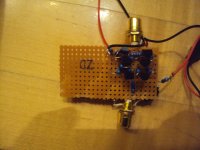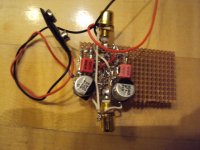Here we go .....
How does it compare to Rosi and Nonbrainer circuits presented here?
Yes, Self has studied the effect too and a bigger cap solves the problem. Semelab is doing a lot of second source so that is good. I have no problem getting the Hitachis but sometime you get the E grade that is a bit shallow on Hfe. Anyway, the offset problem can be solved easy. In the beginning of my thread there was a fears discussion on how much offset is allowed. We came to the conclusion the less the better. I then presented listening tests of how much was audible and then later showed how DC can be trimmed away. By that time nobody was interested in the solution any more so reply was nil. Thats the way i experienced it.
I have some THAT340P's (Matched P and N pairs in a DIP14) in the transistor drawer! Will try it this afternoon.
Kamis, it has a lot of the PRAT factor these transimpedance circuits have but it is also well balanced slightly on the sweet side so it is a very good compromise. It does not reach the nth detail that my best stages have and the bass is very tight and rhythmic but not as seismic as my DC coupled stages. On turntables that have a slight rumble problem this is a good choice. In my system i would make the 470uF caps bigger. Noise is good but not exceptional. At very high volume i can hear a soft and faint hiss that is not there with my best stages but then we speak about stages that have up to 8 trannies paralleled, in one case even more ( 13 ). Hum is nil and what really surprised me was the "quality" of the noise. When i fully crank it the hiss has a really soft character without the impulsive popcorn noise that some bipolars have. 1/F noise is also low. There is not much noise in the bass so this old and tired BD437/438 are not so bad at all. JLH must have made a lot of experiments. I would say that i get 85% of the sound of my best stages but they are much more complicated and expensive to make. The relationship between effort and result is superb and the small flaws it may have are forgotten after 5 minutes of the needle in the grove. I decided also to build my version. It´s really simple. Let us see how that performs.
Well, it is not a big deal. I rebuild to post 2498 and that works although with some offset
( ca. 200mV ) and gain is only x12 so the 10kHz square has an overshot. That can be cured i think.
( ca. 200mV ) and gain is only x12 so the 10kHz square has an overshot. That can be cured i think.
I made further measurements and the idle in the output transistors is only 3mA. I must have made a mistake. Jumpering the 3.3 Ohm works too. Gain is now 30dB, quite ideal but wait until i am finished.
Kamis, it has a lot of the PRAT factor these transimpedance circuits have but it is also well balanced slightly on the sweet side so it is a very good compromise. It does not reach the nth detail that my best stages have and the bass is very tight and rhythmic but not as seismic as my DC coupled stages. On turntables that have a slight rumble problem this is a good choice. In my system i would make the 470uF caps bigger. Noise is good but not exceptional. At very high volume i can hear a soft and faint hiss that is not there with my best stages but then we speak about stages that have up to 8 trannies paralleled, in one case even more ( 13 ). Hum is nil and what really surprised me was the "quality" of the noise. When i fully crank it the hiss has a really soft character without the impulsive popcorn noise that some bipolars have. 1/F noise is also low. There is not much noise in the bass so this old and tired BD437/438 are not so bad at all. JLH must have made a lot of experiments. I would say that i get 85% of the sound of my best stages but they are much more complicated and expensive to make. The relationship between effort and result is superb and the small flaws it may have are forgotten after 5 minutes of the needle in the grove. I decided also to build my version. It´s really simple. Let us see how that performs.
Of circuit published here , which complete MC /MM phono stage is the best in quality of reproduction ? I think that you should make some summary of a large number of designs you have made if you wish to help the members of this forum to start building something realy ultimate in quality. You may quote No. of post with circuits, rejecting less elaborate ones.I think four top designs with different topologies would be enaugh. Forum members should no waste time with others threads textbook level circuits.
Good suggestion, but you have to admit that Mr Gerhard's random approach is interesting to those who think phono stage all day.
Jacco, are you the one that makes Mosfet AB amps ? 🙂
Kamis, some time ago i published a circuit that is an amalgam of all i learned here.
I think i called it the MPP2011 and Jan Didden made an offer to lay it out. Unfortunately there was no reaction from the forum. I will go back on the tread and find it. Then i will publish it again. It was with a Fet input stage. I will publish another stage with BJTs at the input so we have two official circuits. I think that is enough. Both circuit can be build AIOG
or with a two stage approach so we have our 4 circuits. Is that a good idea ? I will begin with one circuit first.
Kamis, some time ago i published a circuit that is an amalgam of all i learned here.
I think i called it the MPP2011 and Jan Didden made an offer to lay it out. Unfortunately there was no reaction from the forum. I will go back on the tread and find it. Then i will publish it again. It was with a Fet input stage. I will publish another stage with BJTs at the input so we have two official circuits. I think that is enough. Both circuit can be build AIOG
or with a two stage approach so we have our 4 circuits. Is that a good idea ? I will begin with one circuit first.
the one that makes Mosfet AB amps
Never ! :-(
=> http://www.diyaudio.com/forums/solid-state/54781-commercial-product.html#post615023

Attachments
Here is the Fet version of the official MPP2011 Fet AIOG. It contains more or less all that i think is good and right. I will work out the details over the next few days. Who will make a PCB ? Should i do a PSU or should we ask somebody else.
Attachments
All the transistor annotations appeared on the second page of the pdf document on my pc. Does anybody else have that too?



